Contenst:
2. Zodiac signs of an astronomical clock
3. Rising sun
4. Setting sun
5. New moon
6. First quarter of the moon
7. Last quarter of the moon
8. Full moon
10. Moon’s descending node
11. Solar eclipse
12. Lunar eclipse
13. Equinox March, LP 21st of March
14. Equinox June, ZP 21st of June
15. Equinox September, HP 21st of September
16. Equinox December, WP 21st of December
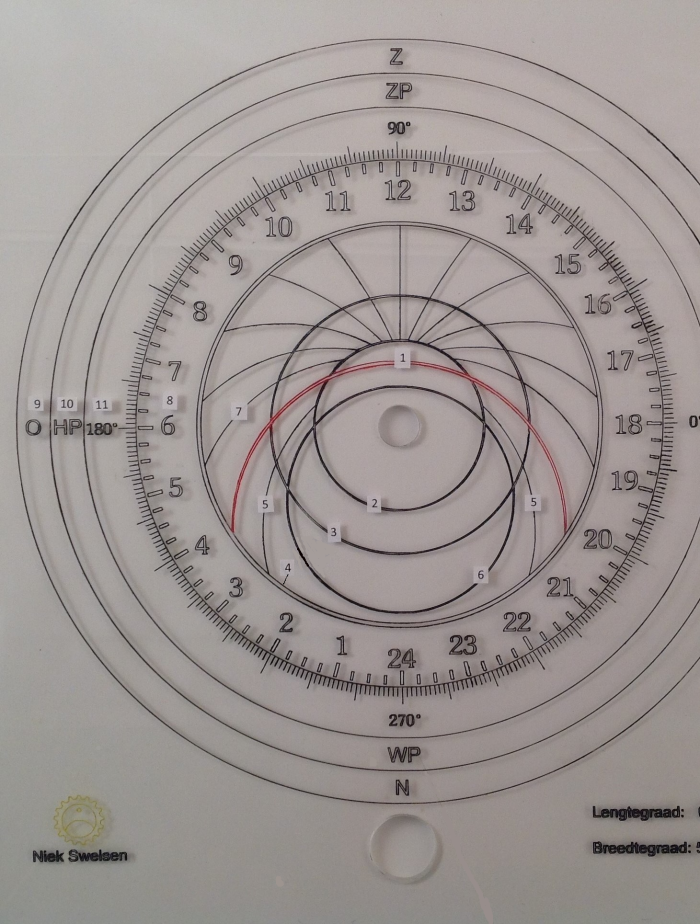
1. Dial astronomical clock
To read the hand positions of an astronomical clock correctly it is important to understand the dial.
1. The red arc represents the horizon. Just below the number 1 is the position where you apparently are and observe. This is the centre point of your astronomical observations, also called the zenith.
2. This circle is the stereographical projection of the tropic of Capricorn. A stereographical projection is a projection of the tropic of Capricorn to a horizontal flat, the dial.
3. This circle is the stereographical projection of the equator.
4. This circle is the stereographical projection of the tropic of Cancer.
5. These arches indicate the degree of twilight and darkness. At sunrise in the East there is a transfer of a complete darkness to full daylight. At sunset in the west there is a transfer of full daylight to complete darkness. For rising and setting sun applies: minus 6 degrees below the horizon is civil twilight, minus 12 degrees is nautical twilight an minus 18 degrees is complete darkness which is ideal for astronomical observations.
6. Within this circle there is complete darkness. The sun is more than minus 18 degrees below the horizon. The degree of darkness depends on the distance of the sun below the horizon. During winter the sun is far below the horizon the stars are better observable than in the summer.
7. These are 12 arc sectors from East to West. These arches represent the unequal hours, the so called Babylonian hours. During the winter the sun low above the horizon and the apparent daylight hours are short. During the summer the sun is high above the horizon and the apparent daylight hours are long.
8. Because an astronomical clock is a representation of a one day rotation of the Earth, around it’s axel, the division is from 0 to 24 hours (on some astronomical clocks a division of 2 x 12 hours can be seen).
9. Within this circle the E-Z-W-N directions are displayed; East at 6 o"clock in the morning. South at 12 o'clock in the afternoon. West at 6 o'clock in the evening and North at midnight.
10. In this circle the 4 solstice points are displayed equinox March LP, equinox June ZP, equinox Septmber HP and equinox December WP. At LP and HP solstice (equinox) the duration of the day is the same as the duration night.
11. In this circle is division from 0 to 360 degrees. The 0 degrees is positioned in the West at the spring time LP. The Earth passes her annual orbit around the sun in spring time equinox March LP, summer equinox June ZP, autumn equinox September HP and winter equinox December to return to spring time LP after a year.
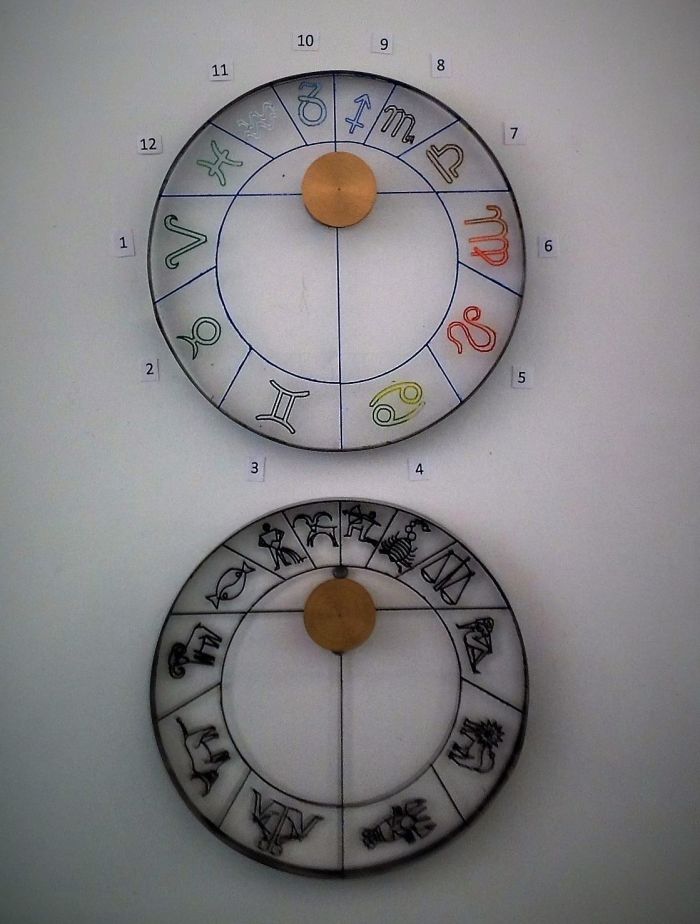
2. Zodiac astronomical clock
The zodiac of an astronomical clock is divided into 12 zodiac signs. Seen from the Earth the sun passes the 12 zodiac signs during the year. Approximately 30 degrees per zodiac sign.
The course the sun follows through the zodiac signs is called ecliptics. On the next photo the ecliptics are on outer rim of the zodiac signs. The band on which the constellations are displayed is called the zodiac.
The centre point of the zodiac is concentric because the zodiac is a stereographical projection of the constellations on a horizontal display, the dial.
The centre point of the stereographical projection is the position of where we are on earth, the point above our head is called the zenith. For the Netherlands this is 52 degrees northern latitude (NB) and 6 degrees eastern longitude. Photo; upper zodiac displayed with symbols of the constellations and the lower picture the zodiac displayed with the signs of the constellations.
Constellations and the period in which the sun is in particular constellation, as observed from the Earth:
1. Aries 20/03 – 20/04 7. Libra 23/09 - 23/10
2. Taurus 20/04 – 21/05 8. Scorpio 23/10 - 22/11
3. Gemini 21/05 – 21/06 9. Sagittarius 22/11 - 21/12
4. Cancer 21/06 - 23/07 10. Capricorn 21/12 - 20/01
5. Leo 23/07 - 23/08 11. Aquarius 20/01 - 18/02
6. Virgo 23/08 - 23/09 12. Pisces 18/02 - 20/03
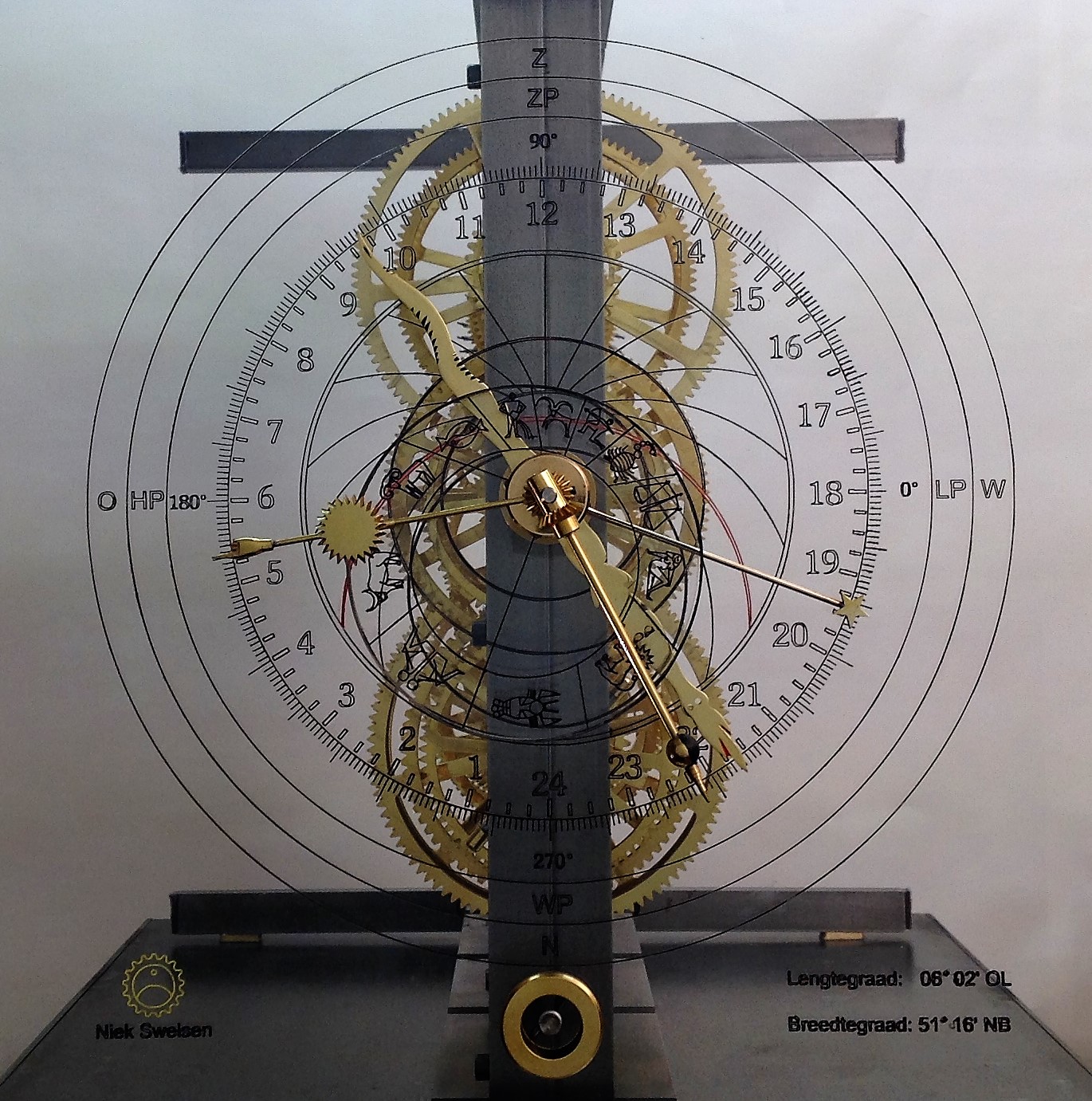
3. Rising sun
Photo: the sun, the hand with the small hand rises in the East at 05:17 am in the constellation Taurus. The red arc is the horizon. The sun dial displays the average sun time where the astronomical clock is situated.
MET (Middle European Time):
MET is the time we keep in Eurpe from the 15 degrees meridian. This meridian is aligned with the town Görlitz located on the border of Poland and Germany. The time difference between MET and our local mean time in the Netherlands is approximately 33 minutes. In summertime that will be approximately 1 hour and 33 minutes.
Sometimes astronomical clocks are provided with three hands:1. A hand indicating the average suntime at the location of the clock. Using a so-called time equalization table, you can calculate the true solar time on a given date.
2. A hand indicating the European winter time (MEWT), also known as the cilvilan winter time, in the zones of the 15-degree meridian.
3. A hand indicating the European Central Time (MEZT), also known as the civilian summertime, in the zone from the 15 degree meridian + 1 hour.

4. Setting sun
The sun sets in the West at 7:15 pm and is positioned in the constellation Taurus.

5. New moon,
The moon is positioned between the sun and the Earth.
The moon is illuminated at the rear by the sun. Due to the sun's backlight the moon is not observable from the Earth. The phase of the moon is called new moon. The moon shall continue its orbit around the Earth after “new moon” and increasingly deflect light to the Earth, the so called “crescent moon”.
How is it possible that from Earth we always see the same side of the moon?
The time the moon needs for one rotation around its own axel is equal to the time the moon turns around the Earth. Both the axel rotation time of the moon and the lunar time of the moon around the Earth is 29,53 days. The speed of the moon in its orbit around the Earth is not constant because the moon orbit is eclipse shaped.
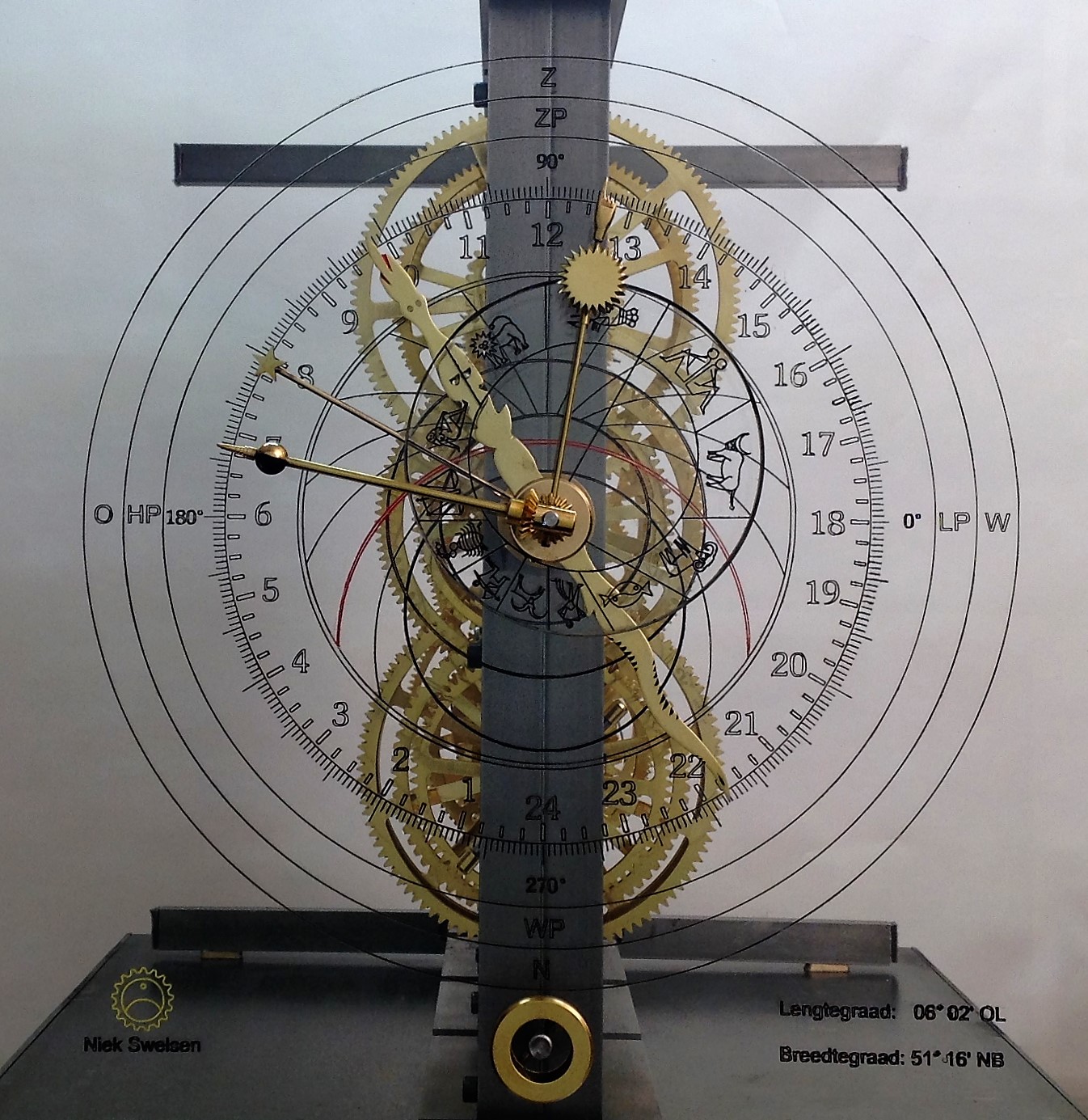
6. First quarter of the moon
After new moon the moon passes to the East. The moon reflects increasingly more light on the right site off the moon. This phenomenon is called crescent moon. After approximately 7,5 days half of the moon is illuminated by the sun. This phase of the moon is called “first quarter”.

7. Last quarter of the moon

8. Full moon
The Earth is positioned between the sun and the moon. The Moon is completely illuminated by the sun except when there a complete or partial lunar eclipse. In this case the moon is positioned in the shadow cone of the Earth. The moon shall continue its orbit around the Earth after “full moon” and decreasingly deflect light to the Earth, the so called "waning moon".

9. Climbing knot
The Earth turns counter clockwise in the area of the sun, the so called ecliptic area. The Earth turns counter clockwise on her own axle. The moon turns counter clockwise around the Earth. Because the moon turns slower around the Earth then the Earth than the Earth turns around her own axel, the moon shifts approximately 13 degrees from West to East per day. The moons lane around the Earth is not parallel to the area of the ecliptic. The lane of the moon makes an angle of 5 degrees with the area of the ecliptic. During this whole lapse of the moon around the Earth the moon passes the ecliptic area twice. When the moon passes the ecliptic area from below to above we call it the climbing knot. On an astronomical clock this moment is diaplayed when the moon passes the “head of the dragon hand”.
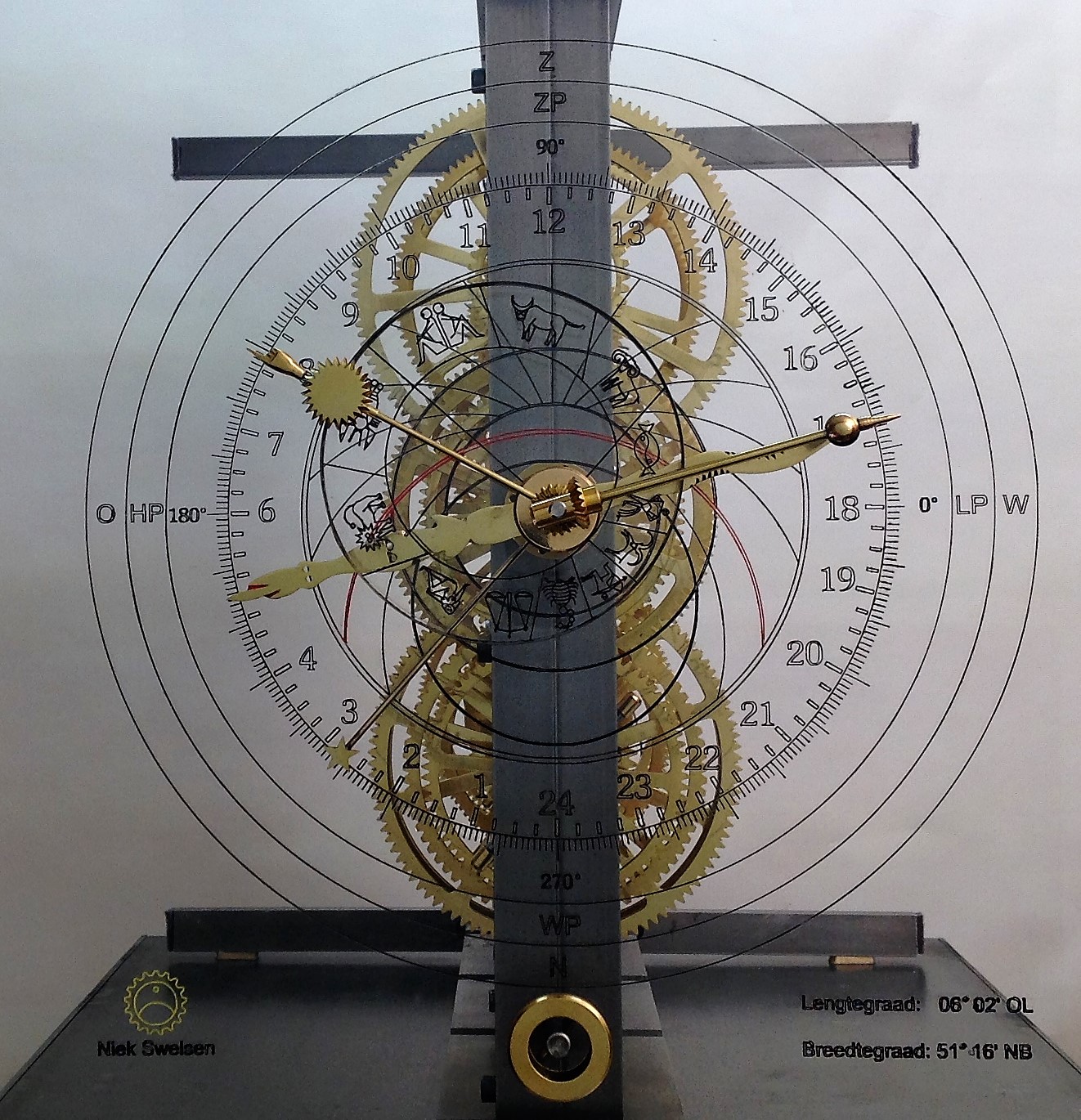
10. Setting Knot
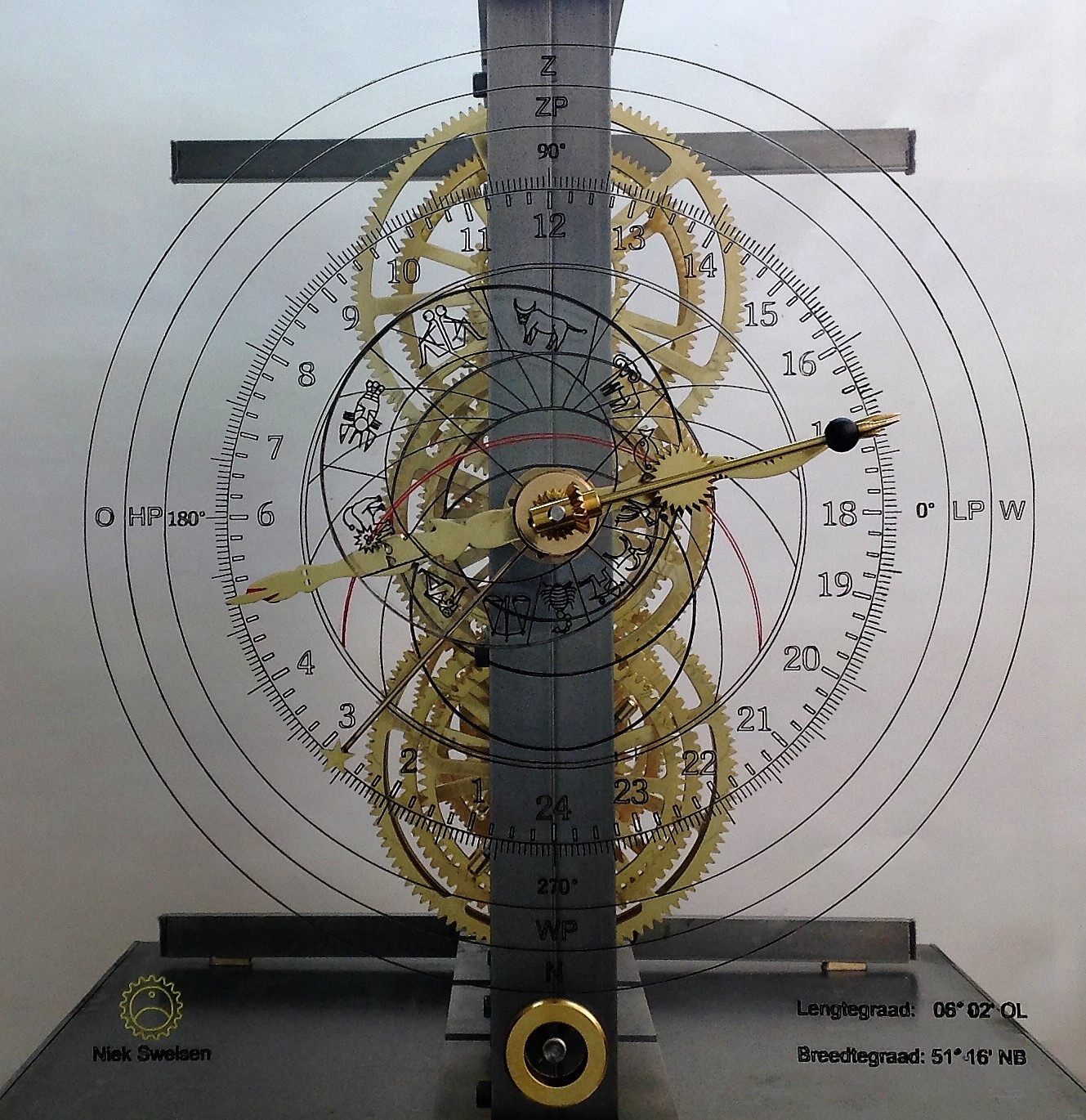
11. Eclipse
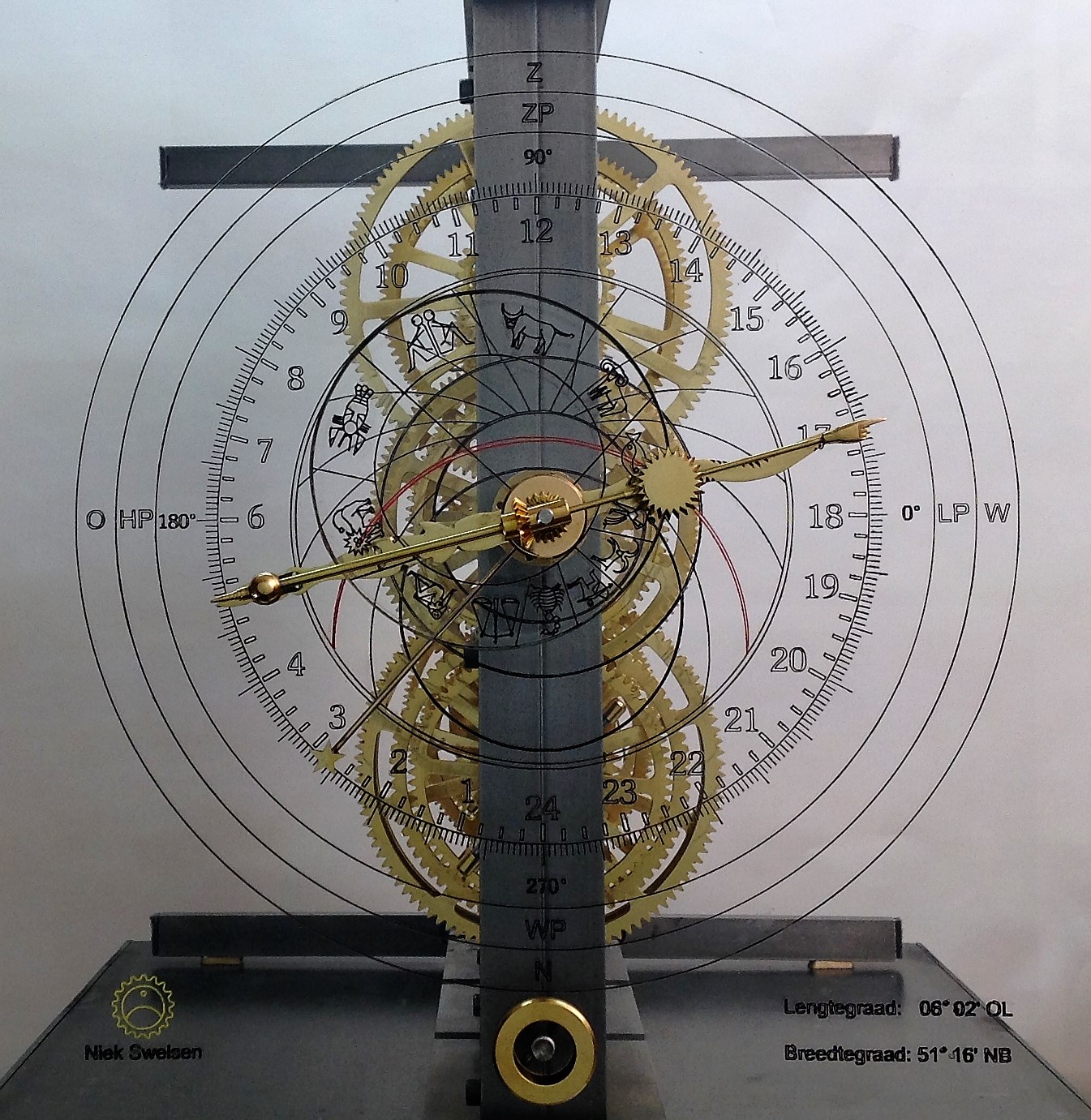
12. Lunar eclipse
.jpg)
13. Spring time 20 – 21 March

14. Summer time point 20 – 21 June
15. Autumn point 22 – 23 September
When the Earth has accomplished 180 degrees of it’s path around the sun, the Earth is positioned in the so-called autumn time point (equinox autumn). The sun is positioned in the beginning of zodiac sign “Libra”. Day and night are equally long (equinox) and is annually observable at variable times on the 22th 23th of September. On this day around noon the sun is positioned 38 degrees above the horizon. On the photo it’s 12 o’clock in the afternoon.

16. Winter point 21 December
The annual orbit position of the Earth starts at 0 degrees spring time point.
When the Earth has accomplished 270 degrees of its path around the sun, the Earth is in the so-called wintertime point (equinox winter). The sun is in the beginning of zodiac sign “Capricorn”. On the 21th of December the nightlight-time is longer than the daylight-time. This phenomenon is noticeble each year at a different time between 20th and 21st of December. On this day the sun is positioned 14 degrees above the horizon. around noon. On the photo it’s 12 o’clock in the afternoon.
